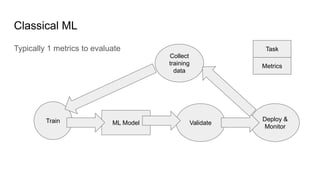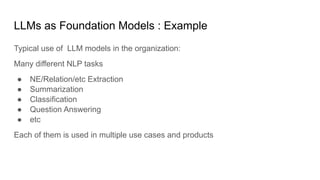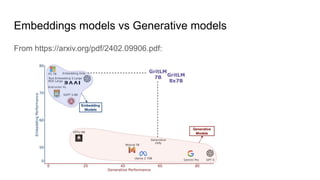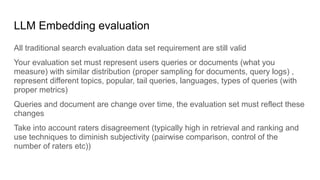Evaluating LLM Models for Production Systems Methods and Practices -
- 1. Evaluating LLM Models for Production Systems: Methods and Practices Pragmatic approach Andrei Lopatenko, PhD, VP Engineering
- 2. Importance of Evaluation In the early 2000s, the search engine landscape was marked by fierce competition among several key players, including Google, Yahoo, and Microsoft. Each of these companies boasted a highly talented team of scientists and engineers dedicated to refining their search technologies—encompassing query understanding, information retrieval, and ranking algorithms—according to their specific evaluation metrics. While each company believed their search engine outperformed the competition based on their internal assessments, there emerged one among them that was universally recognized as superior from the perspective of billions of users worldwide. This search engine ultimately rose to prominence, becoming the dominant force in the market. (Google) The moral of this story underscores the critical importance of evaluation as a cornerstone of success.
- 3. Purpose of this presentation My point of view is based on experience building AI systems (Search, Recommendations, Personalization and many other) in last 16 years No metrics is good and final, no evaluation is comprehensive More important to know principles of building good metrics and evaluation data sets and how to apply them to build evaluation of your systems for your business needs, rather than to apply a particular metrics and benchmark invented by someone else for a their tasks, So this presentation is intended to be broad, to show good principles and examples
- 4. LLM Training and Evaluation Pretraining Fine tuning Instruct tuning etc Perplexity MLM Accuracy Cross Entropy loss SQUAD (Super)GLUE SNLI Task specific metrics and benchmarks Performance metrics LLM based systems End to end metrics
- 5. Purpose of this presentation In this presentation, we talk about industrial use of LLM, developing your use cases and products, Most companies will not do pre-training and they will use open source LLM as start of their journey. So we do not discuss SQuaD 2.0, SNLI, GLUE and other LLM evaluation methods used at the early stage of the LLM development (pre-training) Building LLM products in many companies is about fine tuning, instruction tuning of models, training adapters, building LLM augmented systems and continuous circle of improvements of those systems and models
- 6. Content Why LLMs Evaluation is different from the classical ML Evaluation Why to evaluate & Evaluation Driven Process Types of Evaluation End to End evaluation Evaluation Harnesses
- 7. Classical ML Typically 1 metrics to evaluate ML Model Train Validate Deploy & Monitor Collect training data Metrics Task
- 8. Foundational Models (including LLM) The model is used for many different tasks There are many metrics and many metrics ML Model Train Validate Deploy & Monitor Collect training data Metrics Task Task Task Metrics Metrics Task Metrics Task Metrics Task Metrics
- 9. LLM Tasks Wide variety of tasks is a typical for use patterns of LLMs in every business https://aclanthology.org/2022.em nlp-main.340.pdf
- 10. LLM Diversity of semantic areas LLMs are used for very different semantic areas with the same business . The performance may vary significantly See for example https://arxiv.org/pdf/2009.03300.pdf Or Fig 3 from https://arxiv.org/pdf/2401.15042.pdf
- 11. LLM Evaluation / Continuous process There are multiple steps in training LLM, each of them require own evaluation sets Typically, early stage , pre-training is evaluated on standard NLP metrics such as SQuaD 2.0, SNLI, GLUE that are good to measure standard NLP tasks In this deck, we will focus more on late stage evaluation (fine tuning and after), as they train LLM for your specific tasks and needs to be evaluated against specific tasks
- 12. LLMs as Foundation Models : Example Typical use of LLM models in the organization: Many different NLP tasks ● NE/Relation/etc Extraction ● Summarization ● Classification ● Question Answering ● etc Each of them is used in multiple use cases and products
- 13. LLM : Difference in eval vs classical ML Different fundamental capabilities of LLM to be evaluated ● Knowledge ● Reasoning Higher Risks: LLMs outputs are frequently directly exposed to customer/business experience (conversational experiences), risk function is high (think about recent launch announced from bigTech) There are new types of errors due to emerging behaviours, no evaluation methods for them Complexity of the LLM output makes evaluation more complex (the evaluation requires semantic matching, format, length evaluation – depending on tasks the LLM performs)
- 14. LLM Evaluation - naturally hard Subjectivity of the textual output in many tasks, scores are subjective. Evaluation requires expertise, domain knowledge, reasoning Answers are long, formatting and semantic matching needs to be a part of evaluation LLM functions to evaluate are very diverse : ● Reasoning tasks, requires specific evaluation (ex ConceptArc) https://arxiv.org/abs/2311.09247 ● Multi turn tasks, requires a specific evaluation (ex LMRL Gym) https://arxiv.org/abs/2311.18232 ● Instruction following https://arxiv.org/pdf/2310.07641.pdf
- 15. LLM Why to Evaluate? Validation of model changes : Will they improve the product? Is it a good users’ experience? Will the system become better? New Product Launches: yes/no decisions, can we launch a new product based on the LLM Continuous Improvement of the users experience <- design of the correct metrics to drive the LLM improvement in the right direction , evaluation driven development (as test driven development in software engineering)
- 16. LLM Evaluation Worst case behaviour vs Average case behaviour vs Best case: all are needed all represent various aspects of the system (many benchmark are focused onaverage case ) Risk estimates: evaluation to cover worst risks As LLMs are used for many different cases, complexity of evaluation by semantic category and type of task : semantic coverage is required (the same LLM might have very different metrics value for different topic) LLM Evaluation is similar to evaluation of Search Engines such as Google where many metrics are needed evaluating different aspects of behavior of the evaluated object
- 17. LLM Evaluation / Continuous process LLM will drive many different use cases in the company Most likely there be several LLMs within the same company due to naturally different requirements on latency, costs, serving scenarios, accuracy for specific tasks driven by different products But each LLM will be driving many different use cases/products/experiences Improving each LLM possibly leads to many downstream improvements means very large ROIs as LLM become mature in the company
- 18. LLM Evaluation / Continuous process Continuous work assumes frequent experimentation and frequent evaluation of new versions of your LLMs To do it: 1. Evaluation process must be fast and cheap, automated (many scientists will work in parallel, frequency of experimentation must be encouraged, evaluation should not be a bottleneck ) 2. Evaluation metrics must be correlated with customer and business metrics (requires work on metrics, open source benchmarks are good to bootstrap efforts, but your metrics must represent your users and your business) 3. Evaluation must cover different aspects of use of the LLM (both by tasks and by semantic category and from NLP metrics to production metrics to end-to-end system metrics)
- 19. Necessary Requirements to the Evaluation Alignment (the atomic measurement of the process is aligned with custom or business quality demand for that process) - measurements Representation - a set of measurements represents the whole process (sampling, weighting, aggregation represent the whole population) - datasets Systems - evaluation process does not change the system, cheap, fast, measures the intended measurement Statistics: measurement are done through small sample set, fast, interpretable, confident (statistics, data science)
- 20. LLM Embedding Evaluation Embeddings generation is and will be one of the most important applications of LLM as they are needed for many high impact use cases (search, recommendations, question answering, RAG) The problem - embedding are to used for many different customer facing tasks, for many different types of entities, for many different modalities, many different fundamental tasks (ranking, retrieval, clustering, text similarity etc)
- 21. Embeddings models vs Generative models From https://arxiv.org/pdf/2402.09906.pdf:
- 22. LLM Embedding evaluation MTEB ( Massive Text Embedding Benchmark) is a good example of the embedding evaluation benchmark https://arxiv.org/pdf/2210.07316.pdf https://huggingface.co/spaces/mteb/leaderboard It’s relatively comprehensive - 8 core embedding tasks: Bitext mining, classification, clustering, pair classification, reranking, retrieval, semantic text similarity (sts), summarization and open source
- 23. LLM Embedding Evaluation MTEB evaluation - Learning: no clear winner model across all tasks, the same most probably will be in your case, you ll find different model-winners for different tasks and may need to make your system multi-model MTEB: Easy to plugin new models through a very simple API (mandatory requirement for model development) MTEB: Easy to plugging new data set for existing tasks (mandatory requirement for model development, your items are very different from public dataset items)
- 24. LLM Embedding Evaluation There are standard ‘traditional IR’ methods to evaluate embeddings such as recall @ k, precision @ k, ndcg @ k that are easy to implement on your own and create dataset representing your data They are even supported by ML tools such as MLFlow LLM Evaluate Important learning: find metrics that truly matches customer expectations (for ex NDCG is very popular but it’s old and it was built in different setting, one most probably needs to turn it to their system, to represent the way users interact with their system)
- 25. LLM Embedding Evaluation Another critical part of LLM evaluation for embedding evaluation is software performance/operations evaluation of the model Cost, latency, throughput In many cases, embeddings must be generate for every item on every update (ex: 100M+ updates per day), or for every query (1000000+ qps with latency limits such as 50ms) The number of model calls and the latency/throughput requirements are different for embedding tasks rather than other LLM tasks. Most embedding tasks are high load tasks
- 26. LLM Embedding evaluation All traditional search evaluation data set requirement are still valid Your evaluation set must represent users queries or documents (what you measure) with similar distribution (proper sampling for documents, query logs) , represent different topics, popular, tail queries, languages, types of queries (with proper metrics) Queries and document are change over time, the evaluation set must reflect these changes Take into account raters disagreement (typically high in retrieval and ranking and use techniques to diminish subjectivity (pairwise comparison, control of the number of raters etc))
- 27. LLM Embeddings In most cases, core tasks are serving several tasks facing customers/business. For example, text similarity might be a part of discovery/recommendation engine (text similarity of items as a one of features for the similarity of items ) or ranking (query similarity as if historical performance one of query is applicable as click signals for another query). Evaluation is not only text similarity LLM output, but the whole end-to-end rank,recommendation etc output
- 28. In Context Learning (ICL) Evaluation ICL is a hard task as it requires complex reasoning from LLMs (understand the task, examples, figure how it works, apply to new tasks using only contextual clues) Hard to evaluate since it’s hard to define a loss function ICL has a practical value (code generation, fast learning of classifiers, etc ) Many data sets for ICL Eval: PIQA, HellaSwag, LAMBADA ICL tasks typically require to solve a wide range of linguistic and reasoning phenomena, See examples: https://rowanzellers.com/hellaswag/, OpenICL Framework: https://arxiv.org/abs/2303.02913
- 29. ICL - Evaluation PIQA Selection from multiple answers, only one is correct (PIQA tests commonsense reasoning, physical interactions) LAMBADA Predict the last word of multi sentence passage (Lambada tests: deep comprehension, context dependent language tasks )
- 30. Ethical AI evaluation Many different cases of what makes AI unethical require different evaluation metrics Many practical case are classifiers that have to to classify the LLM output (toxicity, racism) . It’s still very open area and very domain dependent Beliefs encoded in the LLMs - detection and measurement see https://arxiv.org/pdf/2307.14324.pdf Deceptive behaviour https://arxiv.org/pdf/2308.14752.pdf (see chapter 4.3 as a survey on detection techniques -> evaluation )
- 31. LLM as a judge Human ratings - expensive, slow, Can LLM evaluate other LLM (typically evaluated is much largre model) Pros: Automated evaluation, flexible, complex, interpretable Cons: Expensive (both API/computation costs and time) No 100% confidence in the results, they need to be verified Ref: https://arxiv.org/abs/2306.05685
- 32. LLM as a judge Create a template grading task using LLM as a judge providing examples for grading scores Create the first training set Verify the quality of evaluation (by humans) Iterate until getting a good agreement between LLM and human evaluation Run your evaluation (either on training set, or live in production or in other scenarios). Advantage of LLM as a judge - can be run on live traffic Grading LLM typically is more complex than the graded LLM (the cost of evaluation can be controlled by sampling)
- 33. LLM as judge The LLM as a judge may agree with human grading but it requires work on designing and tuning grading prompt templates Costs can be saved by using cheaper LLMs (but requires experimentation and tuning prompt templates and examples) or through sampling techniques The judge model can provide interpretation and explanation assuming the right template For alignment with human scores, important to measure interhuman alignment (this theme is frequently neglected in academic community, some tasks are inherently subjective)
- 34. Evaluation of RAG as example of LLM App evaluation RAG architectures will be one of the most frequent industrial pattern of LLM usage ● Correctness ● Comprehensiveness ● Readability ● Novelty/Actuality ● Quality of information ● Factual answering correctness ● Depth ● Other metrics Similar to a traditional search engine evaluation as we evaluate a requested information but there is a substantial difference as we evaluate generate response rather than external documents Traditional IR architecture: retrieval -> ranker, RAG architecture : retrieval -> generator, different type of evaluation
- 35. Evaluation of RAG A problem, comparison of generated text (answer) with the reference answer. Semantic similarity problem Old lexical metrics (BLEU, ROUGE) are easy to compute but give little usable answers BERTScore, BARTScore, BLEURT and other text similarity functions Calls to external LLMs
- 36. RAG Evaluation 3 typical metrics Context Relevance Answer Relevance Groundedness (precision) (common across multiple frameworks RAGAs, ARES, RAG Triad of metrics) but
- 37. Evaluation of RAG - RAGAs Zero Shot LLM Evaluation 4 metrics: ● Faithfulness, ● Answer relevancy ● Context precision ● Context recall Important to enhance to what represents your RAG intents for your customers https://arxiv.org/abs/2309.15217 https://docs.ragas.io/en/stable/ RAGAs framework integrated with llamaindex and LangChain
- 38. RAGAs Question Answer Context Ground Truth (human curated) Context Precision Context Recall Answer Relevance Faithfulness Retrieval q-> c(q) Generation c(q) -> a_c(q)
- 39. Evaluation of RAG - RAGAs Faithfulness consistency of the answer with the context (but no query!) Two LLM calls, get context that was used to derive to answer, check if the statement supported by the context Context Relevance how is the retrieved context “focused” on the answer , the amount of relevant info vs noise info , uses LLM to compute relevance of sentences / total number of retrieved sentences Answer Relevancy is the answer relevant to the query , LLM call, get queries that may generate answer, verify if they are similar to the original query Context Recall (ext, optional) if all relevant sentences are retrieved , assuming existence of ground_truth answer
- 40. RAGAs Faithfulness : LLM prompt to decompose answer and context into statements F = supported statements / total statements Context Relevance: LLM Prompt to decompose contexts into sentences and evaluate if the sentences are relevant to the question CR = sentences in the context / relevant sentences Answer Relevance: LLM prompt to generate questions for the answer. For each question generate embedding. Compute the average semantic similarity score between original query and all generated queries AR = 1/n sum sim(q, q_i) Context Recall: CR = GT sentences attributed to recall / GT sentences
- 41. Evaluation of RAGs - RAGAs Prompts should be well tuned, hard to move to another context, or LLM, requires a lot of work on tuning of prompts Each metrics: faithfulness, answer relevancy, context relevance, context recall can be dependent on your domain/business. It requires tuning to measure that your business depends upon Available in open source : https://docs.ragas.io/en/stable/ integrated with key RAG frameworks More metrics in new version (Aspect Critique, Answer Correctness etc )
- 42. Evaluation of RAG - ARES (Automated RAG Evaluation System) https://arxiv.org/abs/2311.09476 Focused on trained few short prompter rather than zero short prompting Demonstrates accurate evaluation of RAG systems using few hundred human annotations Shows accurate evaluation despite domain shifts Evaluates LLM for the metrics: context relevance, answer faithfulness, and answer relevance. Statistical techniques to get confident answers from few hundred measurements
- 43. ARES Inputs ● a set of passages from the target corpus ● a human preference validation set of 150+ annotated datapoints ● five few-shot examples of in-domain queries and answers, which are used for prompting LLMs in synthetic data generation.
- 44. RAG Evaluation ARES From https://arxiv.org/pdf/2311.09476.pdf
- 45. ARES ● Generation of synthetic data. Generate synthetic question answers from the input corpus passages using generative LLM (including negative examples, techniques are presented in the paper) ● For Faithfulness, Answer Relevance, Context Relevance, fine tune LLMs using binary classifier as a training objective. Human preference annotation set is used to evaluate model improvement ● Sample in domain Query - Answer - Context triple and classify them using LLMs Authors report that ● Ranking of RAG systems is more reliable than pointwise scoring of them due to noise in the synthetic data ● More accurate measures than RAGAs by leveraging domain adaptive techniques for prompting and using PPI method
- 46. RAS and ARES have to be customized For your particular system: ● Metrics ● Prompts ● Datasets and annotations
- 47. Code Generating LLMs : Evaluation Problem: the generated code is not used on its own, it’s a part of code writing process managed by code. How to evaluate generated code to be used as a part of development work Can human recognize bugs in the generated code? Is generated code easy to use / modify / integrate? Problems of evaluation are similar to many other LLM evaluation scenarios
- 48. Code Generating LLMs: HumanEval A popular approach to evaluate code generating LLMs is HumanEval (by OpenAI), an eval set for code generation https://arxiv.org/abs/2107.03374 https://paperswithcode.com/sota/code-generation-on-humaneval The program is considered correct if it passed unit tests for the problem (in average 7. Unit tests for the problem) pass@k correctness is one of the top k program passes unit tests Not every organization will develop code generation tools, but almost every will use LLM for imperative/action applications: scheduling, routing, home automation, shopping etc and will use LLM to generate action calls
- 49. Other domain specific LLM Evaluation tasks Health-LLM (Health prediction based on wearable sensor data) See https://arxiv.org/pdf/2401.06866.pdf As an example of using LLM for various health prediction tasks and building LLM evaluation sets and tools to evaluate LLM performance for those tasks Evaluation of explanation of recommendations Chapter 4 in https://arxiv.org/pdf/2304.10149.pdf
- 50. Hallucination Evaluation HaluEval https://aclanthology.org/2023.emnlp-main.397.pdf 3 tasks : question answering, knowledge grounded dialog, summarization Responses from the LLM labeled by human annotators The set is focused on understanding what hallucinations can be produced by LLM and the LLM is asked to produce to wrong answer through hallucination patterns (one pass instruction and conversation schema ) ● four types of hallucination patterns for question answering (i.e., comprehension, factualness, specificity, and inference) ● three types of hallucination patterns for knowledge grounded dialogue (i.e., extrinsic-soft, extrinsic-hard, and extrinsic-grouped) ● three types of hallucination patterns for text summarization (i.e., factual, non-factual, and intrinsic) Focus: Understanding Hallucination patterns and understanding if LLM can detect hallucinations
- 51. Pairwise comparison - Arenas How to select ‘the best’ model out of many one? How to rank a set of models by their quality Game: model vs model on performing a certain task (can be very flexible such as an arbitrary question from the user). A set of evaluation tasks: at each step two models ‘play’ against each other, human rates the best answer, themmodel with the best answer ‘wins’ the game The task: predict which model wins more frequently
- 52. Arena Chatbot arena for generic user tasks https://chat.lmsys.org/ Negotiation area for negotiation tasks https://arxiv.org/pdf/2402.05863.pdf A paper from Cohere about model ranking based on tournaments https://arxiv.org/pdf/2311.17295.pdf
- 53. Arena Such arena/tournament setting are useful for raking many very different models vs generic tasks - open source community, But they are applicable in your setting too 1 evaluation of many models and *version of models* 2 results of evaluation are easy to interpret 3 possible to modify tasks (sub domain/ sub tasks) , make results more interpretable
- 54. Model vs Model evaluation Comparative study is useful for incremental improvements of the same model Model vs model evaluation ● intepretation/deeper understanding of model change, ● measures both improvement and degradation ● useful in case of small model changes Supported by some cloud providers (Google Vertex AI AutoSxS) but in most cases requires to build your own evaluation
- 55. Evaluation harnesses Tasks, how many different types of tasks can harness support Speed / Scalability, how fast is it to run evaluation tasks. Does it scale with the number of GPUs/compute power for the evaluation system, scalability by the data sets Easy to use code base, is it easy to modify at the code level, adopt to new tasks, support of various coding scenarios, integration with other open source tools (fast inference with vLLM, hugging face transformers) Evolvability, easy to add new models, new tasks, new data sets, new metrics Harness are very complicated products, hard to develop on your own, open source harnesses are very valuable
- 56. Evaluation Harnesses EleutherAI/lm-evaluation-harness, very powerful, for zero and few short tasks OpenAI Evals bigcode-project/bigcode-evaluation-harness, code evaluation tasks MLFlow LLM Evaluate , integrated with ML Flow, MosaicML Composer, icl tasks, superfast, scaling to multi gpu RAGAs for LLM based evaluation https://docs.ragas.io/en/latest/ TruLens
- 57. Evaluation Harnesses EleutherAI - HuggingFace leaderboard uses it Well integrated with many OS LLM software libraries Supports many metrics and evaluation set s, supports third party models Many other things (LORA adapters evaluation) Widely used and tested (hundreds papers ), Nvidia, MosaicML, Cohere etc use it Scales well for multi GPU vLLM integration Easy to create a new zero or few short evaluation tasks
- 58. LLM In production LLM are used in production, in online serving, streaming, batch scenarios Besides NLP Evaluation metrics, LLMs should support the required load and support required experience from software performance point of view For example, one might have LLM generating embedding representing the query or supporting semantic parsing or classification of the search query with the requirement to handle 1000000+ qps and 50 millisecond latency limit (online servin) or process thousands of phone call transcripts every several minute (in batch processing) or continuously process crawled web pages (~ 1B per day, )
- 59. LLM In production GPU Utilization metrics Total latency (to produce the full output), throughput as the total number of tokens per sec generated across all users and queries Time to produce the first token, time to produce the whole response, time per token for each user (here a lot of control points, for example, latency can be reduced by prompt producing shorter output without change of the model) Operational metrics such as the percentage/number of ‘Model is overloaded’ responses, Costs: (a lot of optimization tricks, more about systems rather than models per se)
- 60. LLM In production End to end evaluation User engagement metrics: engagement rate, response rate, negative response rate Response quality: length of response, time between reading and responding, explicit quality response (thumbs up and down etc), garbage responses (by stage in the LLM funnel that typically involved other systems) Session metrics: length, time of engagement, number of engagement per session or “Average Size Basket, return rate
- 61. Q&A Thank you




























































